Energy & Environment
Indias Energy Landscape
Powering Growth with Sustainable Energy
Posted On:
22 JUN 2025 9:55AM
|
Key Takeaways
- India’s total installed power capacity reached 476 GW as of June 2025.
- Power shortages dropped from 4.2% in 2013–14 to 0.1% in 2024–25.
- Over 2.8 crore households were electrified, per capita electricity consumption increased by 45.8%.
- Non-fossil fuel sources now contribute 235.7 GW (49%) of total capacity, including 226.9 GW renewable and 8.8 GW nuclear.
- Thermal power remains dominant, accounting for 240 GW or 50.52% of installed capacity.
|
India has made significant progress in strengthening its energy sector in recent years. The country is successfully balancing the twin goals of meeting rising electricity demand and promoting sustainability. According to the International Energy Agency (IEA), 85% of the increase in global electricity demand over the next three years will come from emerging and developing economies. As one of the fastest-growing major economies, India plays a central role in the global energy transition. Its energy demand is expected to grow at the fastest rate among major economies, driven by sustained economic growth. Consequently, India's share in global primary energy consumption is projected to double by 2035.
Over the past decade, India’s power sector has seen robust expansion driven by rising demand, infrastructure development, and strong policy support for both conventional and renewable energy sources. Electricity generation has increased from 1,168 billion units (BU) in 2015–16 to an estimated 1,824 BU in 2024–25. Similarly, total installed capacity has grown from 305 gigawatts (GW) in 2015–16 to a projected 475 GW in 2024–25.
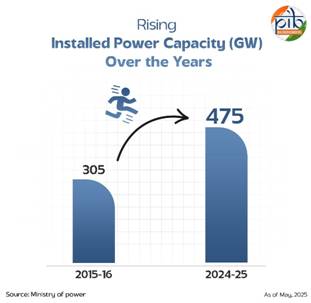
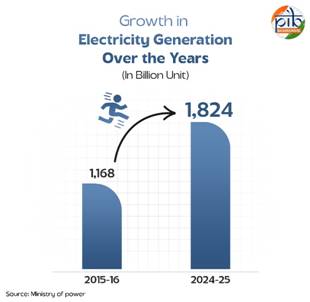
|
India achieved 100% village electrification by April 2018 and has since connected more than 2.8 crore households to the grid.
|
During this period, the Ministry of Power implemented key reforms to improve access, efficiency, and reliability. Important initiatives include the creation of a unified national power grid, the Deen Dayal Upadhyaya Gram Jyoti Yojana (DDUGJY) for rural electrification, and the SAUBHAGYA scheme aimed at universal household electrification.
- Reduction in Power Shortages: Energy shortages reduced from 4.2% (2013-14) to 0.1% (2024-25).
- Increased Consumption: Per capita electricity consumption rose by 45.8% to 1,395 kWh in 2023-24 from 957 kWh in 2013-14.
India’s power sector is among the most diversified in the world, with generation from conventional sources like coal, gas, hydro, and nuclear, as well as renewable sources such as solar, wind, biomass, and small hydro. With rising electricity demand, India continues to expand its energy capacity to support economic growth and sustainability goals.
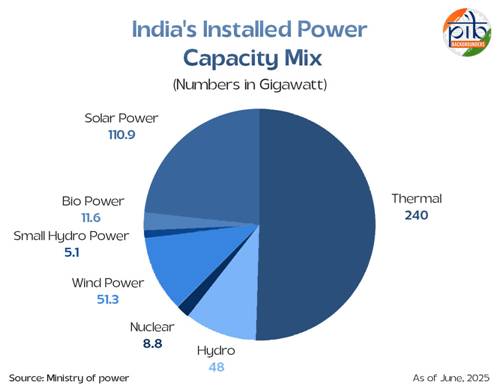
As of June 2025, India’s total installed power capacity has reached a significant milestone with 476 GW, led by 240 GW of thermal, 110.9 GW of solar, and 51.3 GW of wind power, marking a strong shift towards renewable energy and energy security.
Record Non-Fossil Fuel Capacity Additions
India’s Commitment to Clean Energy
Over the past eleven years, India has made remarkable progress in the renewable energy sector. In line with the commitment made at COP26, the Ministry of New & Renewable Energy (MNRE) is working tirelessly to achieve 500 GW of installed electricity capacity from non-fossil fuel sources by 2030. As of June 2025, the country has already achieved 235.7 GW from non-fossil fuel sources, comprising 226.9 GW of renewable energy and 8.8 GW of nuclear power, accounting for 49% of the total installed power generation capacity of 476 GW. This marks a significant step toward India’s decarbonisation goals and its pledge to a sustainable future.
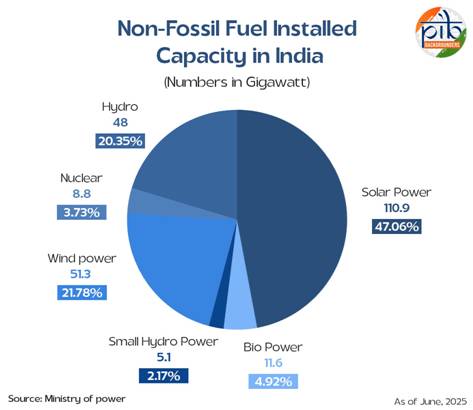
Key Achievements (2014–2025)
- Global Leadership:
As per IRENA RE Statistics 2025, India ranks 4th globally in Renewable Energy Installed Capacity, 4th in Wind Power, and 3rd in Solar Power capacity.
- Expansion in Renewable Energy Capacity:
Installed RE capacity has grown from 76.37 GW in March 2014 to 226.79 GW in June 2025, an increase of nearly 3 times.
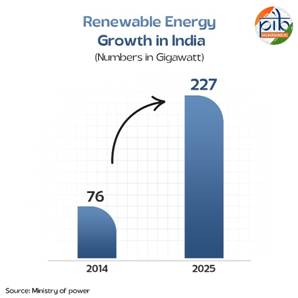
- Growth in Generation
Renewable energy generation rose from 190.96 BU in 2014–15 to 370.65 BU in 2024–25 (April 2024–February 2025), with its share in overall power generation increasing from 17.20% to around 22.20%.
|
In addition to the installed capacity, 176.70 GW worth of RE projects are under implementation, with 72.06 GW under bidding stages.
|
Solar Power
Solar capacity has increased more than 39 times, from 2.82 GW in 2014 to 110.9 GW in 2025, including a record 23.83 GW added in 2024–25 alone.
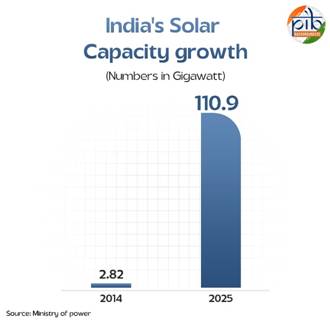
- Manufacturing Boost (2014 to March 2025):
- Solar PV module capacity surged from 2.3 GW to 88 GW, a 38-fold increase.
- Solar PV cell capacity grew from 1.2 GW to 25 GW, a 21-fold increase.
Wind Energy Sector
India has emerged as a global leader in wind energy, particularly in onshore wind power. With an evolving manufacturing ecosystem, supportive policies, and new strides in offshore development, the country is making significant progress in both capacity addition and infrastructure. India currently ranks 4th in the world for installed wind power capacity.
India’s Wind Energy Achievements (2014–2025)
- Installed capacity increased from ~21 GW in 2014 to 51.3 GW by June 2025, more than doubling in a decade.
- 4.15 GW added in FY 2024–25 alone.
- Electricity generation by wind energy rose to 78.21 billion Units (BU) between April 2024 and February 2025, contributing 4.69% to total electricity generation.
- Domestic manufacturing strengthened with 31 certified wind turbine models being manufactured by 14 Indian companies and 18 GW annual manufacturing capacity.
|
As per National Institute of Wind Energy, the estimated wind potential of the country is 1164 GW at 150 meters above ground level.
|
|
The International Solar Alliance (ISA), launched in 2015 by India and France at COP21, is the first treaty-based intergovernmental organisation headquartered in India. With a 2020 amendment, all UN member states became eligible to join the ISA. As of March 2025, 122 countries have signed the ISA Framework Agreement, and 105 have ratified it.
|
|
Prime Minister of India at the First Assembly of the International Solar Alliance (ISA) in Oct 2018, had called for One Sun – One World – One Grid (OSOWOG). It is a global initiative to create a transnational solar power grid based on the idea that “The Sun Never Sets.” The International Solar Alliance (ISA) is leading its implementation. Phase-I of the study has been completed and approved, and further work is in progress. A task force was also set up in 2021 to explore grid interconnections with regions including South Asia, Middle East, Africa, and Europe.
|
Hydropower Expansion
Hydro capacity increased from 35.8 GW to 48 GW from FY 2014 to FY 2025. Targeting 55 GW by FY 2030, supported by Inter State Transmission System (ISTS) charges waivers and equity assistance for North East projects.
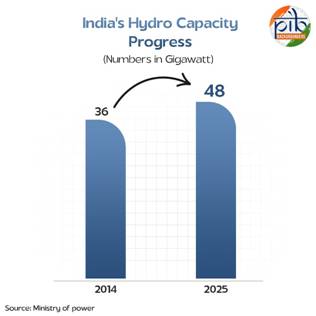
Bio Power
Biopower generation capacity has increased from 8.1 GW to 11.6 GW over the last 11 years. Compressed Biogas (CBG) generation capacity expanded from a single project with 8 Tonnes per Day (TPD) in 2014 to 150 projects with a cumulative capacity of 1,211 TPD as of March 2025.
National Bioenergy Programme (2021–26)
|
As of 31 March 2025:
- Cumulative installed capacity of Biomass power and cogeneration capacity: 9.82 GW (Bagasse & IPP) and 0.92 GW (Non-Bagasse).
- Cumulative installed capacity of Waste to Energy capacity: 840.21 MWeq (309.34 MW grid-connected, 530.87 MWeq off-grid).
- Under the Biomass Programme, Cumulative installed capacity: 11.583 GW.
- Installed biogas plants: 51.04 lakh small and 361 medium, with cumulative 11.5 MW off-grid power generation capacity.
|
The Ministry of New and Renewable Energy launched the National Bioenergy Programme on 2 November 2022. It covers the period from 1 April 2021 to 31 March 2026. The total budget outlay is ₹1715 crore. Phase-1 has been approved with ₹858 crore, including committed liabilities.
The programme includes three parts:
· Waste to Energy Programme – Uses urban, industrial, and agricultural waste.
· Biomass Programme – Supports briquette and pellet plants and biomass-based cogeneration.
· Biogas Programme – Supports small (1–25 m³/day) and medium (25–2500 m³/day) biogas plants.
Flagship Schemes & Programmes
|
As of April 2025:
- 50.03 lakh applications received
- 11.88 lakh households benefitted
|
1. PM-Surya Ghar: Muft Bijli Yojana
Launched in February 2024, this scheme aims to provide 1 crore households with free electricity through rooftop solar systems. With an outlay of ₹75,021 crore, it targets an addition of 30 GW in solar capacity through rooftop solar in residential sector, potentially generating 1 lakh crore units over 25 years and reducing 720 MMT of CO₂ emissions.
A dedicated national portal ensures easy registration, vendor empanelment, and subsidy tracking.
2. PM-KUSUM Scheme
|
Achievements (as on 31.03.2025):
- 563.48 MW capacity installed under Component A
- 7.70 lakh agriculture pumps installed under Component B
- 3.39 lakh pumps solarized under Component C
|
Launched in March 2019, the objective of the scheme is to enhance farmers’ income by providing energy and water security and de-dieselisation of the farm sector. The scheme provides financial support to the farmers for installation of standalone solar pumps and solarization of existing grid-connected agriculture pumps, and installing solar power plants on their barren/fallow agricultural land. The scheme targets the addition of 34.8 GW of solar capacity across the country, with a total financial outlay of ₹34,422 crore.
Three major components:
-
- A: 10,000 MW of Decentralized Ground Mounted Grid Connected Solar Power Plants.
- B: Installation of 15 lakh standalone Solar Powered Agriculture Pumps.
- C: Solarisation of 35 Lakh Grid-connected Agriculture Pumps including through Feeder Level Solarisation.
Now all components are covered under the Agriculture Infrastructure Fund (AIF) for easy financing.
- Target: 40 GW by March 2026
- Approved: 55 parks, capacity of 39,958 MW in 13 States
- Commissioned: 12,804 MW in 24 parks
|
3. Solar Parks Scheme
This scheme facilitates large-scale grid-connected solar power projects with required infrastructure like land, power evacuation facilities, road connectivity, water facility etc. along with all statutory clearances.
4. PLI Scheme for High Efficiency Solar PV Modules
The PLI Scheme for High Efficiency Solar PV Modules aims to boost domestic manufacturing. It also reduces import dependence. The scheme has an outlay of ₹24,000 crore. Under the scheme, Letters of Award have been issued for setting up of 48,337 MW of fully / partially integrated solar PV module manufacturing capacities.
Including the additional capacities setup by the PLI beneficiaries in excess of the capacities awarded under PLI Scheme, as of 31.03.2025, the capacities which have started production include around 17 GW of solar PV module manufacturing, around 6 GW of solar PV cell manufacturing and around 2 GW of ingot-wafer manufacturing.
5. PM JANMAN: Empowering PVTG Communities through Solar Electrification
The Pradhan Mantri Janjati Adivasi Nyaya Maha Abhiyan (PM JANMAN) was launched to address the development needs of Particularly Vulnerable Tribal Groups (PVTGs) through 11 critical interventions across 9 Ministries. A key initiative under this mission and Dharti Aaba Janjatiya Gram Utkarsh Abhiyan (DA JGUA) is the New Solar Power Scheme, with an outlay of ₹515 crore, aimed at electrifying one lakh un-electrified households in Tribal and PVTG habitations across 18 states, promoting inclusive growth and sustainable energy access in remote tribal areas.
|
Target:
- 1 lakh households
- Providing off-grid solar lighting in 1500 Multi-Purpose Centres (MPCs)
- Solarization of2000 public institutions
|
Progress:
- 2057 HHs electrified (as of 31.03.2025)
|
India’s Expanding Nuclear Energy Programme
India’s nuclear energy sector has witnessed significant expansion and modernisation over the past decade. With a focus on clean energy, indigenous technology, and performance excellence, the country has scaled up both its operational capacity and future potential.
Key Achievements in Nuclear Energy (2014–2025)
- 60% increase in annual nuclear electricity generation:
From 35,592 MUs (2014–15) to 56,681 MUs (2024–25).
- 71% rise in installed nuclear capacity:
Grown from around 4,780 Megawatt (MW) in 2014 to 8,780 MW in 2025, across 25 nuclear reactors operated by Nuclear Power Corporation of India Limited (NPCIL).
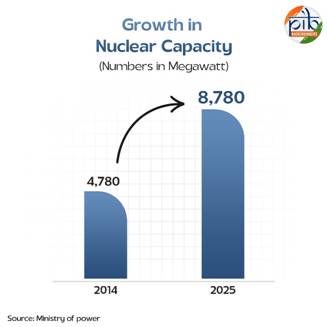
- 87% Plant Load Factor achieved in Financial Year 2024–25
- Capacity Factor and Availability Factor above 80% for all operating reactors over the past five years.
|
New reactors commissioned:
-
- Kudankulam Nuclear Power Plant (KKNPP) Unit-1 (1000 MW) – December 2014
- KKNPP Unit-2 (1000 MW) – March 2017
- Kakrapar Atomic Power Project (KAPP) Unit-3 (700 MW) – June 2023
- Kakrapar Atomic Power Station (KAPS) Unit-4 (700 MW) – March 2024
- Rajasthan Atomic Power Project (RAPP) Unit-7 (700 MW) – April 2025
|
National Green Hydrogen Mission
The National Green Hydrogen Mission (NGHM), launched in January 2023, with a financial outlay of ₹19,744 crore till 2029–30, is a flagship initiative to position India as a global leader in green hydrogen production and export. It aims to promote energy self-reliance, reduce carbon emissions, and create large-scale employment in clean technologies.
The expected outcomes of the Mission, by 2030, are as follows:
India’s Green Hydrogen production capacity to reach approximately 5 MMT per annum, contributing to reduction in dependence on import of fossil fuels.
Achievement of Mission targets is expected to reduce a cumulative ₹ 1 lakh crore worth of fossil fuel imports by 2030.
This Mission is likely to leverage over ₹8 lakh crore total investments and create over 6 lakh green jobs in the country.
The mission targets will add over 100 GW of renewable power generation capacity and will result in reduction of nearly 50 MMT per annum of CO2 emissions through production and use of the Green Hydrogen.
India’s Non-Renewable Power Generation
|
As of June 2025:
- Coal remains the dominant contributor with a capacity of 219 GW.
- Gas-based power contributes 20 GW.
- Diesel-based power adds another 589 MW.
|
India’s energy sector is heavily reliant on non-renewable thermal sources, which together account for the largest share of the country’s electricity generation capacity. Thermal power alone accounts for 50.52% of India’s total installed energy capacity, underscoring its central role in meeting the nation’s electricity demands.
These sources collectively make up a total thermal capacity of 240 GW. Among them, coal alone contributes over 91% of the total thermal energy, highlighting its critical role in powering the nation.
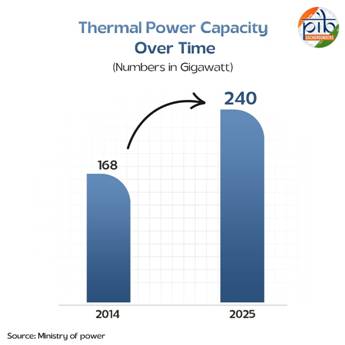
India’s Coal Sector
Over the past eleven years, India’s coal sector has witnessed remarkable transformation under the Ministry of Coal. With a focus on self-reliance, sustainability, and efficiency, major reforms and infrastructure development have enabled record production, significant import reduction, and cleaner, more transparent operations.
Key Achievements (2014–2025)
Revenue sharing with Coal Bearing States
Revenue paid to the Coal bearing states led to improvements in infrastructure, healthcare, education, socio-economic growth, and 'ease of living' for citizens. Coal PSUs distributed a total revenue of ₹ 1.8 lakh crores to coal-bearing states since 2014-15.
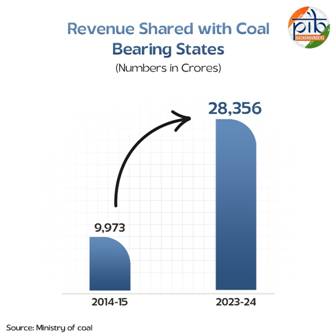
Production & Supply Growth
- Coal production increased from 609.18 million tonnes (MT) in 2014–15 to 1,047.68 MT in 2024–25, a rise of 72%.
- Coal supply grew from 603.77 MT to 1,025.25 MT, meeting rising domestic demand, especially in power generation.
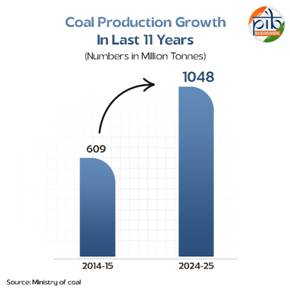
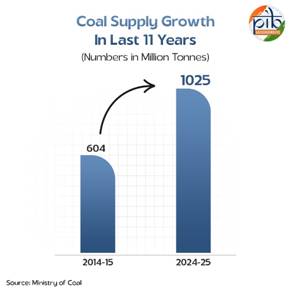
Import Reduction & Savings
- Import dependency has steadily declined since 2014-15, decreasing from 26% to about 21% in 2023-24. In the FY 2024-25 till January 2025, the import dependency has further decreased to 19.60%.
- Coal imports for domestic power plants fell 34.24% during Apr–Jan FY 2024–25 compared to the same period last year.
- Import value dropped, resulting in substantial savings of USD 5.88 billion (₹45,301 crore) in FY 2024–25 (till Jan), showing improved self-reliance.
Commercial Mining Revolution
- 124 coal blocks allocated under the Commercial Mining Policy (launched June 2020); 17 already operational.
- Production from captive/commercial mines jumped from 52.7 MT (2014–15) to 190.95 MT (2024–25), a rise of 262%.

Sustainability & Environment
To ensure a sustainable future, the coal sector is shifting towards a balanced energy mix by adopting renewables like solar and wind, while offsetting past environmental impacts through carbon capture, reforestation, and clean energy initiatives.
- 477.7 lakh trees planted over 21,500 hectares — equivalent to carbon sink of 10.78 lakh tonnes CO₂ eq.
- During FY 2014-15 to FY 2024-25, 17 Eco-parks / Mine Tourism sites / Recreational Parks were established and integrated 7 nos. of parks with the local tourism circuit.
Net Zero target set by Coal PSUs and achievement till date are as under
|
Coal/Lignite PSUs
|
Net Zero Achievement Target
|
Plan to achieve Net Zero by Capacity
|
Commissioned renewable so far
|
|
Solar
|
Wind
|
|
CIL
|
2026
|
3000 MW
|
122.5 MW
|
|
|
NLCIL
|
Achieved
|
300 MW
|
1380 MW
|
51MW
|
|
SCCL
|
2025
|
530 MW
|
245.5 MW
|
|
| |
Total
|
|
1748 MW
|
51 MW
|
*Source-Ministry of Coal
Corporate Social Responsibility (CSR)
- CSR spend by PSUs increased from ₹360.5 crore in 2014–15 to ₹ 739.62 crore in 2024–25 (132% rise).
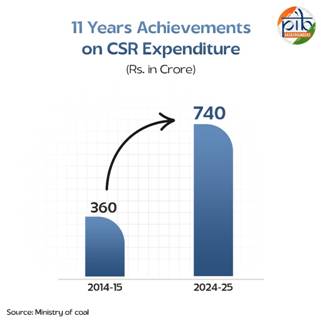
- Total spend in past 11 years: ₹6,418 crore, benefiting 3.5 crore citizens.
- Flagship projects in healthcare, skill development, aspirational districts, sports, and Divyangjan inclusion.
Employment Generation
- 16,209 jobs offered under Mission Mode Recruitment (2014–2025) by CIL & NLCIL.
- Through CSR, Empowered over 62,000 individuals through skilling and livelihood programs.
- Provided digital education infrastructure across 1,263 schools.1,2
Digital Procurement Leadership
- FY 2024–25: ₹2.11 lakh crore procurement of Goods & Services via GeM (from ₹1.01 lakh crore in FY24) – 108% growth.
- Ministry of Coal ranks #1 in GeM procurement among ministries; CIL ranks #1 among CPSEs.63 schools.
Oil and Gas Sector in India: Importance and Achievements
The Oil and Gas sector is one of India’s eight core industries and plays a pivotal role in driving the country’s economic engine. India is the third-largest consumer of oil in the world (as of 2023), making this sector crucial for the country’s energy security and future growth. As India’s GDP is expected to grow to US$ 8.6 trillion by 2040, the demand for energy, especially oil and natural gas, is set to nearly double to 1,123 million tonnes of oil equivalent, making the sector increasingly attractive for both domestic and international investments.
Key Achievements (2014–2025)
- Liquefied Petroleum Gas (LPG) Revolution:
-
- LPG connections increased from 14.51 crore (2014) to 32.97 crore (2025).

- Pradhan Mantri Ujjwala Yojana (PMUY)
- As on 01 March 2025, there are 10.33 crore PMUY connections across India.
- Out of the 8.99 crore connections released as on 01 April 2022,
8.34 crore beneficiaries availed at least one refill during April 2022 - March 2024, indicating sustained LPG usage.
|
Launched in May 2016, PMUY was aimed at providing deposit free LPG connections to adult women from poor households, promoting health, environmental sustainability and women empowerment by replacing traditional cooking fuels like firewood and cow-dung cakes. Under Ujjwala 2.0, a special provision was made for migrant families, allowing them to avail a new LPG connection through a self-declaration instead of requiring Proof of Address and Ration Card.
- Expansion of Piped Natural Gas (PNG) and Compressed Natural Gas (CNG)
- PNG connections grew nearly 6x, from 0.254 crore (2014) to 1.47 crore (2025).
- CNG stations increased more than tenfold, from 738 (2014) to 7720 (2025).
- City Gas Distribution (CGD) network expanded from 53 to 307 for specific geographical areas.
- CGD coverage jumped from 13.27% to nearly 100% population-wise and 5.58% to ~100% area-wise by 2025.
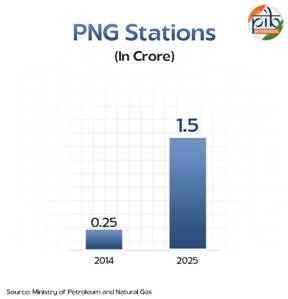
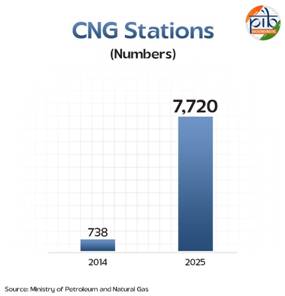
- Natural Gas Pipeline & LNG Infrastructure:
- Operational natural gas pipelines rose from 15,340 km (2014) to 25,124 km (2025).
- Number of LNG terminals doubled from 4 to 8, and their capacity rose from 22 MMTPA to 52.7 MMTPA.
- Biofuel & Ethanol Blending Progress:
- The National Policy on Biofuels (2018, amended in 2022) targeted 20% ethanol blending by 2025-26.
- Ethanol blending increased from 1.53% (2014) to 18.5% (2025).
- Ethanol procurement surged from 38 crore litres in 2014 to 440.74 crore litres in 2025.
- Biodiesel procurement rose sharply from 1.19 crore litres (2015–16) to 43.99 crore litres (2024).
Conclusion
India is not just increasing its energy capacity, it’s reshaping it, tackling climate change head-on while ensuring energy security and providing modern energy access to all. India’s energy journey over the past decade reflects a strategic shift towards self-reliance, sustainability, and innovation. With bold reforms, massive infrastructure expansion, and a strong push for renewables, the country is not only meeting its growing energy demands but also contributing meaningfully to global climate goals. From green hydrogen to solar rooftops, rural electrification to digital procurement, every initiative underscore India’s vision of inclusive, secure, and clean energy for all. As the nation moves forward, its balanced and forward-looking energy strategy continues to power economic growth and a sustainable future.
References
Click here to download PDF
*******
Explainer 21/ Series on 11 Years of Government
Santosh Kumar/ Sarla Meena/ Anchal Patiyal
(Backgrounder ID: 154717)
Visitor Counter : 49649
Provide suggestions / comments